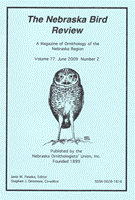Nebraska Ornithologists' Union

Nebraska Bird Review
Date of this Version
6-1990
Document Type
Article
Citation
"Notes," from Nebraska Bird Review (June 1990) 58(2).
Abstract
Notes
EAGLE SURVEY NOTE. This part of the Eagle Survey report was lost between the bottom of page 29 and the top of page 31 of the March issue (NBR 58:29-31):
*The unknown eagle under Niobrara was not identified as either Bald or Golden; all others were Bald Eagles.
--- Greg Wingfield, Nebraska Game and Parks Commission Rt. 4, North Platte, NE 69101
PAINTED BUNTING On 21 May 1988 I spotted a Painted Bunting in the cemetery (nearest to the road leading to the Monument) on the western edge of Gering, Scotts Bluff Co. I saw the bird at approximately 11 :30 AM. It appeared in a wood pile at the north edge of the ravine which bordered the southern edge of the cemetery. The light conditions were good at the time -- full sunlight was above and to my left, and no branches obstructed my view of the Bunting. The bird was in plain view for about 15 to 20 seconds, whereupon it dove further back into the pile. Further attempts to find it, both by myself and by those who went back later, were unsuccessful.
The bird was shaped like a chubby goldfinch, typical of what any species of bunting would be shaped like. The head was rounded, the body proportioned like a finch rather than a warbler; rounder overall. The tail did not extend more than about an inch past the body. I did not note the bill shape as I looked for other field marks first. The bird was a/l green, but it was not all the same shade of green. The head, dorsal regions, and wings were all one shade of bright green, close to what I would call kelly green. This color was consistent throughout these areas of the bird; there was no streaking on the back, no rump or crown coloration, no facial markings, nor any difference in wing color with the exception of the two wingbars, which were the same color as the birds ventral side, a more lime-colored green, more yellow in tone than the dorsal, but still primarily green. This color extended from throat to crissum, and again there was no inconsistency of color -- no streaking, no spotting, nor any other typical underside markings. As for the other parts of the bird, the eye was dark, and I particularly took notice of the flesh around the eye because it was also a very bright green. I did not record leg color.


Comments
Copyright 1990, Nebraska Ornithologists' Union. Used by permission.